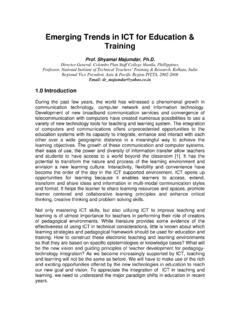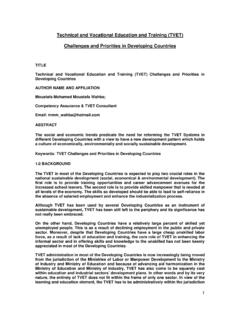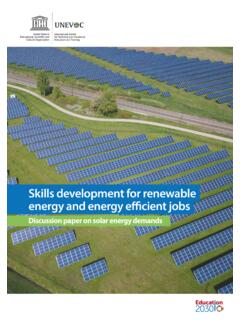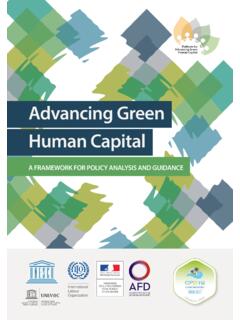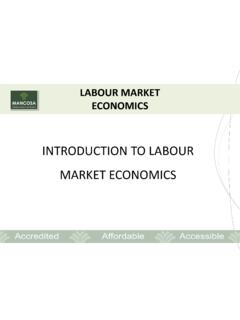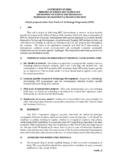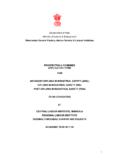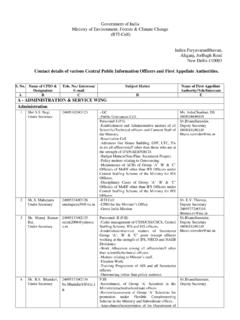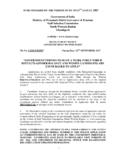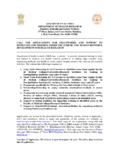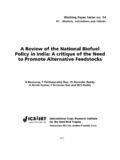Transcription of IN INDIA FOR SUSTAINABLE DEVELOPMENT
1 TECHNICAL AND VOCATIONAL EDUCATION AND TRAINING (TVET) SYSTEM\ IN INDIA FOR SUSTAINABLE DEVELOPMENT Dr. Vijay P. Goel Deputy Director General, Department of Higher Education Ministry of Human Resource DEVELOPMENT , Government of INDIA Abstract INDIA has one of the largest technical manpower in the world. However, compared to its population it is not significant and there is a tremendous scope of improvement in this area. In INDIA , the emphasis has been on general education, with vocational education at the receiving end. This has resulted in large number of educated people remaining unemployed. This phenomenon has now been recognised by the planners and hence there is a greater thrust on vocationalisation of education. Another shortcoming in the area of technical and vocational education is that till now, the number of engineers graduating is more than the diploma holders.
2 This is creating an imbalance, as more workforces are required at the lower level. Hence more polytechnics and Institute for Industrial Training (ITIs) are being opened now. Besides, various Ministries are trying to impart vocational courses through innovative institutions, specially launched for the purpose. In doing so, the government is trying to maintain quality of these courses. Under the XIth Plan, vocationalisation of education has received a boost with more funds being allocated for the purpose. Besides, it is also being ensured that the marginalised sections of the society, including women, get adequate representation in these courses. It can thus be hoped that TVET will play a major role in improving the lives of the people of INDIA . INTRODUCTION. The role of education in facilitating social and economic progress has long been recognized. Education improves functional and analytical ability and thereby opens up opportunities for individuals and also groups to achieve greater access to labour markets and livelihoods.
3 A better educated labour force is essential if we are to meet the labour supply requirements of faster growth. Education is not only an instrument of enhancing efficiency but is also an effective tool of widening and augmenting democratic participation and upgrading the overall quality of individual and societal life. The population growth of INDIA has declined over many years, yet the labour is projected to grow by close to 2% or some 7 million or more per year over next few years. Modernisation and social processes have also led to more women entering the work force lowering the dependency ratio (ratio of dependent to working age population) from in 1991 to in 2001 and is expected to further decline to by 2011. Skills and knowledge are the engines of economic growth and social DEVELOPMENT of any country. Countries with higher and better levels of knowledge and skills respond more effectively and promptly to challenges and opportunities of globalisation.
4 INDIA is in transition to a knowledge based economy and its competitive edge will be determined by the abilities of its people to create, share and use knowledge more effectively. This transition will require INDIA to develop workers into knowledge workers who will be more flexible, analytical, adaptable and multi skilled. In the new knowledge economy the skill sets will include professional, managerial, operational, behavioural, inter personal and inter functional skills. To achieve this goals, INDIA needs flexible education and training system that will provide the foundation for learning, secondary and tertiary education and to develop required competencies as means of achieving lifelong learning. INCLUSIVENESS. As education is the means for bringing socio- economic transformation in a society, various measures are being taken to enhance the access of education to the marginalized sections of the society.
5 One such measure is the introduction of the reservation system in the institutes of higher education. Under the present law, seats in the higher educational institutes are reserved for the scheduled tribes, 15%. for scheduled castes and 27% for the non creamy layers of the Other Backward Classes (OBCs). Under the Indian constitution, various minority groups can also set up their own educational institutes. Efforts are also being taken to improve the access to higher education among the women of INDIA by setting up various educational institutes exclusively for them or reserving seats in the already existing institutes. The growing acceptance of distance learning courses and expansion of the open university system is also contributing a lot in the democratization of higher education in INDIA CONSTITUTION COMMITMENTS. According to the Indian Constitution, Education is a concurrent subject whereby powers are vested both in the Central and State Governments.
6 The Constitution (86th Amendment) Act, 2002, enacted in December 2002. seeks to make free and compulsory education a Fundamental Right for all Children in the age group 6-14 years by inserting a new Article 21-A in Part III ( Fundamental Right') of the Constitution. The new Article 21-A reads as follows: 21 A Right to Education . The State shall provide free and compulsory education to all children of the age of six to fourteen years in such manner as the State may, by law, determine . The Right of Children to FREE and Compulsory Education Bill is the consequential legislation to the Constitutional 86th Amendment Act, 2002, which inserted Art 21 in the Constitution of INDIA to make education for all children in the 6- 14 age group a Fundamental Right. The Bill is anchored in the belief that the values of equality, social justice and democracy and the creation of a just and humane society can be achieved only through provision of inclusive elementary education for all.
7 EDUCATION PATTERN INDIA . The present education system in INDIA mainly comprises of primary education, secondary education, senior secondary education and higher education. Elementary education consists of eight years of education. Each of secondary and senior secondary education consists of two years of education. Higher education in INDIA starts after passing the higher secondary education or the 12th standard. Depending on the stream, doing graduation in INDIA can take three to five years. Post graduate courses are generally of two to three years of duration. After completing post graduation, scope for doing research in various educational institutes also remains open. TECHNICAL AND VOCATIONAL EDUCATION SYSTEM IN INDIA . Technical and Vocational Education plays a vital role in human resource DEVELOPMENT of the country by creating skilled manpower, enhancing industrial productivity and improving the quality of life.
8 The term Technical Education and Vocational Training are sometimes used synonymously. However, as per present practice, the term TE refers to post secondary courses of study and practical training aimed at preparation of technicians to work as supervisory staff. The term VT refers to lower level education and training for the population of skiled or semi-skilled workers in various trades and it does not enhance their level with respect to general education. The main agencies involved in TVET policy formulation and its implementation include: Central Government National Skills DEVELOPMENT Council Ministry of Human Resource DEVELOPMENT Department of School Education and Literacy (for TVET programmes in senior secondary schools). Department of Higher Education (for TechnicalEducation). Ministry of Labour and Employment , Directorate General of Employment and Training (for Vocational Training).
9 There are some other 20 Central Ministies and Departments which have running some small TVET programmes . State Government Directorate of Technical Education Private Sector NGOs TECHNICAL INSTITUTIONS IN INDIA . Education is an area of special focus in the XI Five Year Plan. The Eleventh Plan places the highest priority on education as a centered instrument for achieving rapid and inclusive growth. It presents a comprehensive strategy for strengthening the education sector covering all segments of the education pyramid. Expansion, Quality and inclusiveness is the main objective of the XI Plan. Technical Education is instrumental in making the remarkable contribution to economic growth of the Developing Countries by way of suitable manpower production according to the needs of the Industry, Society and the Global World as a whole. To produce fully skilled manpower/knowledgeable technocrats in the present era of science and technology is the need of the hour.
10 Polytechnic education has responded to the challenges of industrialization for self-reliance. Technical Education covers courses and programmes in engineering, technology, management, architecture, town planning, pharmacy and applied arts & crafts, hotel management and catering technology. INDIA 's general, technical and managerial capabilities are on par with the best of the world countries. While the youth population is fast shrinking with higher dependency ratios in the developed world, INDIA is blessed with the population of about 70 percent below the age of 35 years. Youths are the most vibrant and dynamic segment as well as potentially most valuable human resource. However, despite phenomenal capabilities, INDIA is seriously handicapped with a very weak and narrow knowledge base, with gross enrolment ratio, as compared to 21% in China, in developed countries and the world average of.

